
The old house renovation
By 2019 we had more or less finished the new house and we started to turn our thoughts towards the old house. When we bought the property we were told, very clearly, that we would never be able to change it back to the original layout. Regardless, we hoped to be able to find a way. You might want to read the home page for a better explanation
Some background information: In Italy, when you embark on a construction or renovation project like La Rupina, you have to engage a licenced expert called a “geometra” to make sure you do things correctly, according to the local rules and regulations. The geometra takes care of tasks like drafting building plans, managing construction sites, dealing with permits, and doing land measurements, if required. Our geometra was brilliant and we loved working with him.
And he was starting to formulate a plan.
In order to find out what our renovation options were, our geometra decided that there were two questions we needed to answer: First, could we prove what the original layout was, and second, was there anything in the planning regulations that would allow us to restore the layout to its original form.
The first part involved cutting a hole through the concrete floors in the hallway and in the front rooms.
Our geometra had guessed correctly that there was another floor below the one we stood on and that this would show where the original floor levels were (fist picture).
Next, I had to work my way around the house chiseling plaster off the walls to find all the holes that supported the original floor beams (second picture). This gave us enough visual evidence to be able to work out exactly where the original floor had been, and to work out the old locations of all the doors.
Our geometra then went searching through all the documentation for the house, going through its entire history, both online and old written records, and he was able to demonstrate that no written permission had ever been granted for the original modifications. This would make the work illegal (or “abuso edilizio” as it is called in Italian).
Normally, discovering this sort of thing about a property you own is a disaster, but for us it might be good news. Our geometra’s plan was to declare to the central building authority that the work was an abuso edilizio, pointing out that permission had never been granted.
The work had removed two lightweight wooden floors and replaced them with heavier steel and concrete floors, and this was dangerous and would destabilise the building in an earthquake (more on this subject in a blog post). Also, he argued that the house was a very old historic building and that returning it to its original shape would be an important act of preservation.
All of this bizarrely meant that I had to pay a fine of just under €2,000, as I was the one who owned the building when the abuso was discovered, even though it wasn’t me who did it.
This all happened in the summer of 2020. Covid had appeared in Italy in February 2020 and full lockdown had started in March 2020. Lockdown was lifted in May 2020 and by June 3 travel restrictions also had been lifted.
So it looked as if we were in the clear. Covid appeared to be in retreat and we also realised that this was a great opportunity; we had the good will of various important officials at this point, and if we waited we might miss our chance to fix the house. We had raised the money we would need by selling some land we owned and by drawing down cash from my pension fund.
Financially, it was going to be very tight but we just felt it was now or never. So the paperwork was submitted in late summer of 2020 when it seemed that Covid was over and things were looking up.
And it started so well
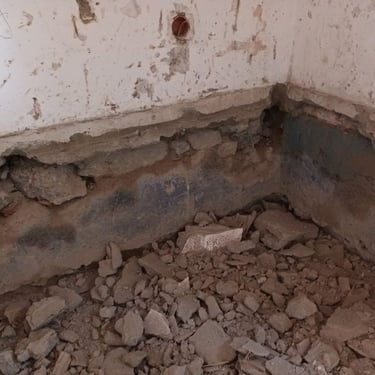

Covid comes back
So far things had gone well, but they were about to take a turn for the worse.
The paperwork had been submitted, but Covid numbers, instead of dropping, were now going back up and things were looking pretty bad. On November 6 lockdown was reintroduced.
Then out of the blue we got the news that our application for the building work had been accepted and that permission had been given for the project to go ahead.
This was a disaster, we were in full lockdown. Building permits come with strict time limits in Italy, but there were no materials to be bought anywhere and no one was available to do the work.
My first thought was to cancel the permission, but that was not possible. We had declared the building dangerous and an abuso edilizio, we couldn't just say that the building was suddenly safe after all. That wasn't going to work.
My next thought was, well at least we have three years to complete everything (normal permission for building work lasts for three years), we can get through Covid and out the other side and get back to normal. But no, that was not an option either. When a building has been declared to be a dangerous structure, a condition for the permission is that the work has to be completed within six months.
The geometra had managed to pull off the most amazing feat by getting the permission but now we were facing an impossible task.
We were looking at a total lockdown for an unspecified period, a total absence of workers and materials, and a deadline that expired at the end of March 2021, six months away. Our budget was very tight and had almost no wiggle room. Even if lockdown was lifted, we would run into Christmas, when everything stops until La Befana (Epiphany) on the 6th of January..........Shit.
Realistically, it looked as if nothing was going to happen until mid-January at the earliest. That would leave us two and a half months to complete a complex renovation. Things were looking very bad.
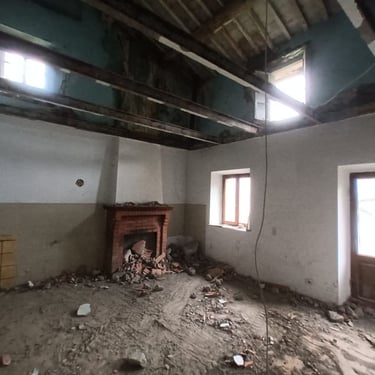



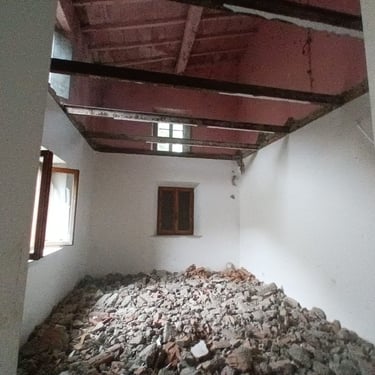
Then suddenly on 6 December lockdown was lifted, and soon after that our builders were on site. One stroke of luck was that the initial stage of reconstruction was preparation of the site and demolition of the old floors. This would not need any materials, which was a good job because there weren't any. Literally none; bags of cement were being rationed, there was no timber, no bricks, nothing of anything.
But at least this total lack of building materials would not hold things back. The initial demolition was going to be the upper floor only, as the builders would need the ground floor to stand on while they worked, and for scaffolding and equipment.
Demolition is fast work and progress was rapid.
Lockdown gone
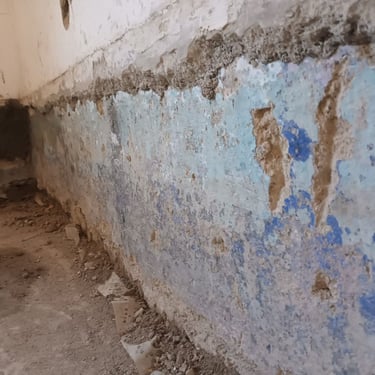

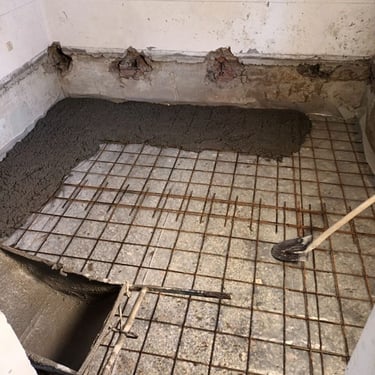
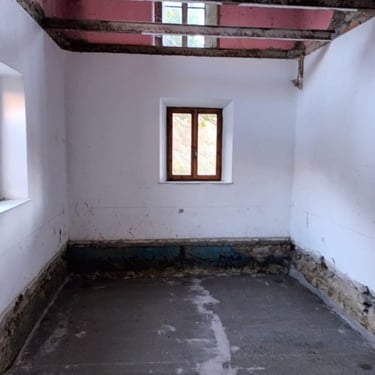

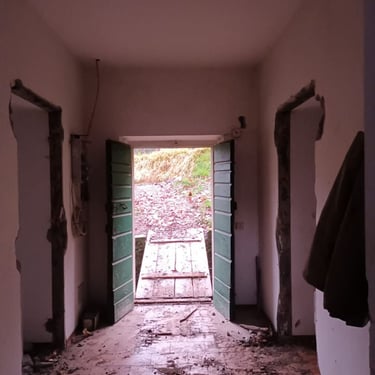
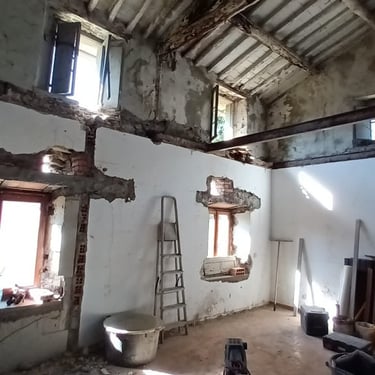
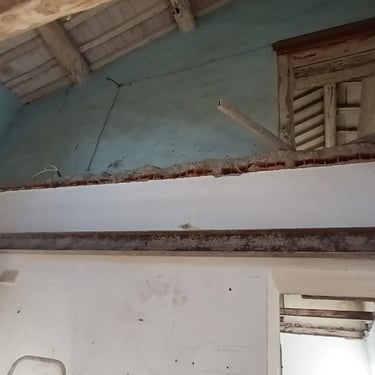
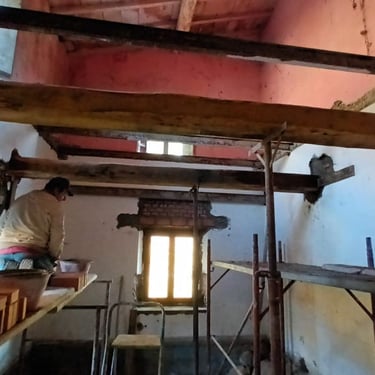
The builders were away for Christmas and stayed away during January, as they had lots of overdue work to juggle. I wasn't the only person who had been affected by Covid, and they were doing their best to keep several jobs going. But by the beginning of February they were back on site and work continued.
Some of the old floors downstairs were on different levels so a damp-proof course (DPC) layer was put down and concrete was poured over the top to get the floors in a level line across the house.
And it wasn't just the floors that were in the wrong place, the windows had previously been raised when the floor was lifted. All the windows at the front of the house now needed to go back down to their original height.
Steel beams that had once held up concrete were repurposed to support what would be the sides of the new wooden floor, and new chestnut beams were inserted into the walls in exactly the same position as the beams in the original construction.
2021 kicks off
With the travi (the long support beams that go across the room) in place, the travicelli (the shorter beams that span the space between the support beams and the walls) could be put into position.
As part of the renovation, we wanted to make the house as earthquake-resistant as possible. Long metal bars were screwed into the travi and extended to the outside of the house. Square metal plates were then fitted over the extending bars and pushed tight up against the outside wall with wedges.
This construction meant that instead of having one or two major points of support for the walls, there were now about twenty all the way around the house at the level of the upper floor and another set at the level of the ground floor.
This, coupled with the reduction in load now that the concrete floors had gone, would make the house much more earthquake resistant.
It was at about this point that we hit another problem: my mother, who lived in the UK, fell ill and had to be admitted to hospital, and I needed to return to the UK to help look after her.
One of the areas I had been hoping to save money on was laying the wooden floors. I had laid floors in the past, albeit on a smaller scale, and I was confident that I could do the work myself. But I now needed to be in the UK to look after my mother, and this meant not being in Italy to work on the floors.
With our completion deadline fast approaching, delaying the work until my return wasn’t an option. We were able to find more workers to do the job in my absence, but it was yet another cost.
Because of Covid, the price of materials had increased dramatically. We had begun this project with enough in the bank to cover the floors and the roof, but I now realised that we were running out of money and we were not going to have enough for the roof.
The beams go in
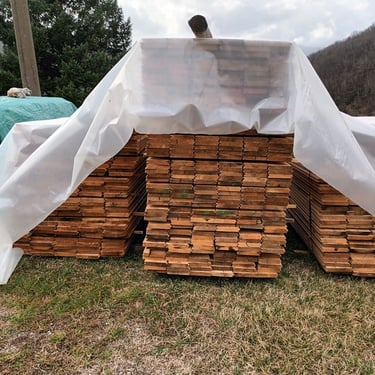
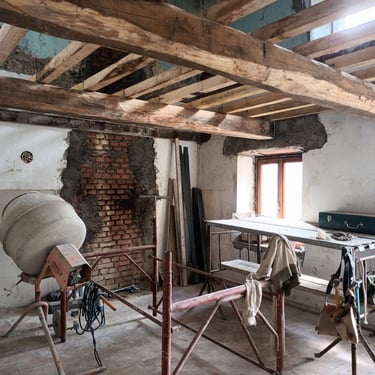


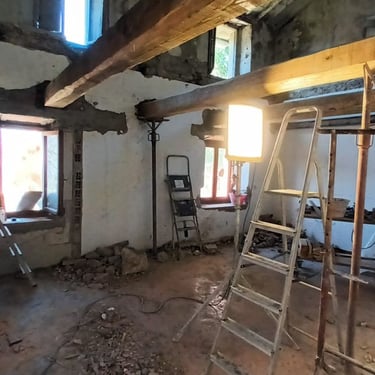
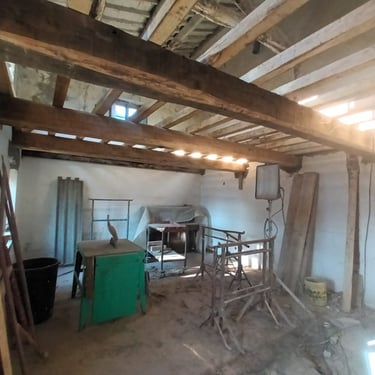
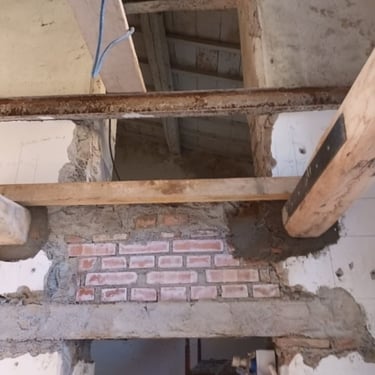

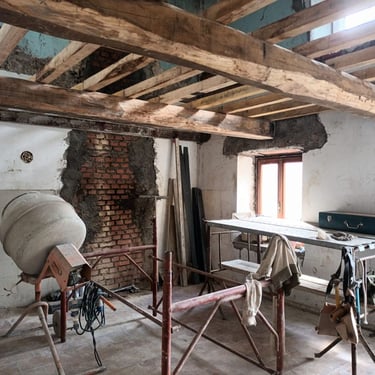

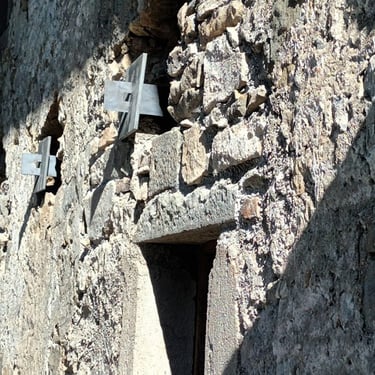
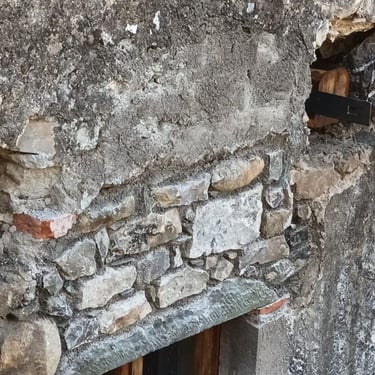
With the floors upstairs laid, all the scaffolding and equipment downstairs could come out and the demolition of the concrete ground floor could begin. There was just one slight problem. A piano.
The piano belonged to my daughter and was a gift from my father when he was alive. It had a massive cast iron frame and weighed an absolute ton. We had managed, with great difficulty, to get it into the house when we originally bought it, but getting it back out was going to be nearly impossible.
So our enterprising builders drilled holes in the wall, inserted a couple of huge rebars, and suspended it above the floor and out of the way.
Job done.
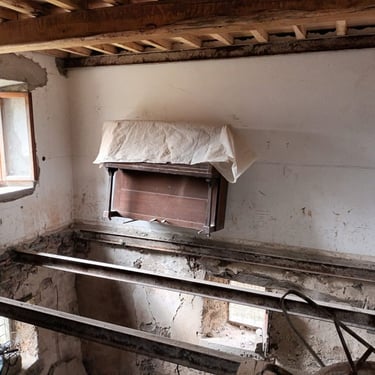
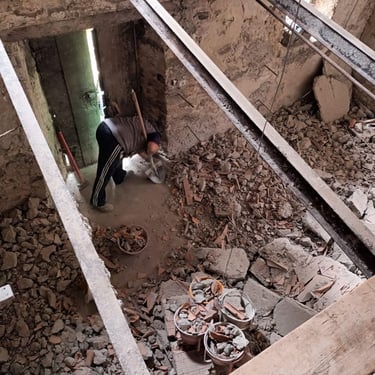

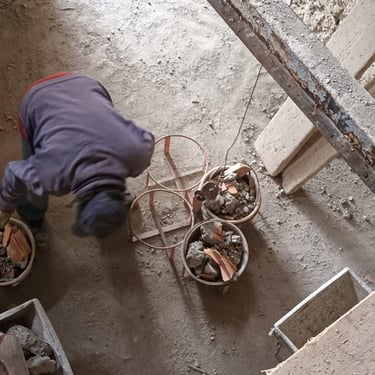
Ground floor comes out

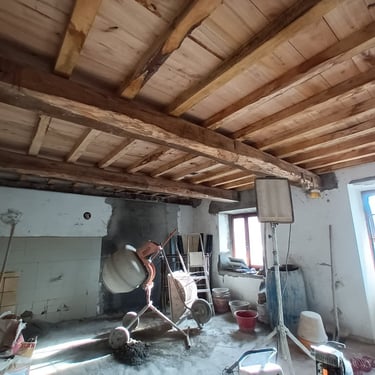

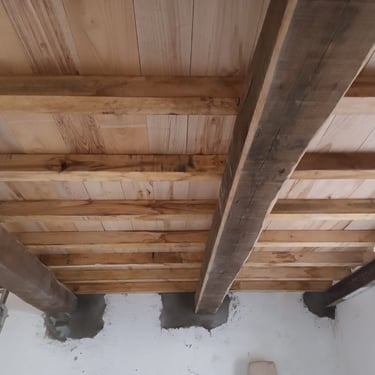
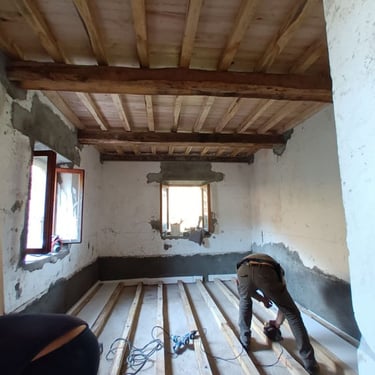

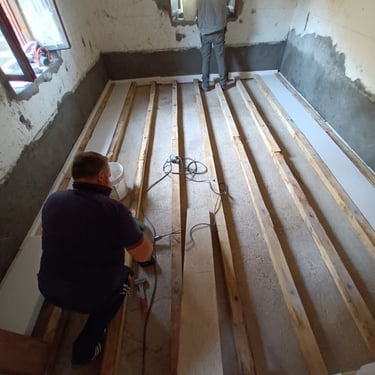

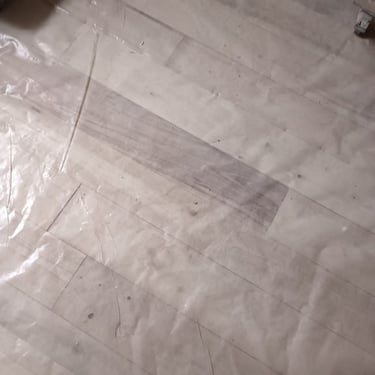
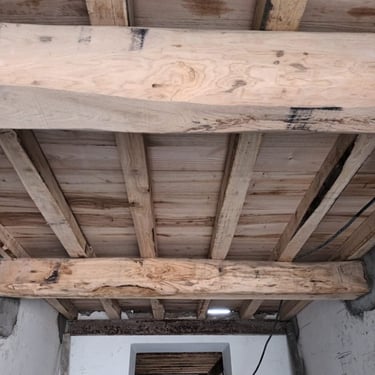

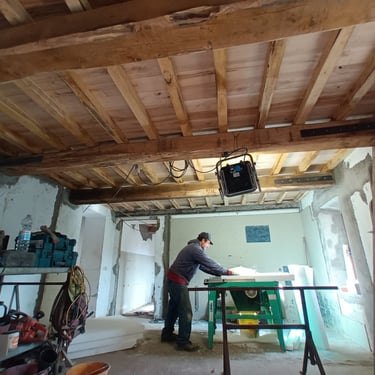
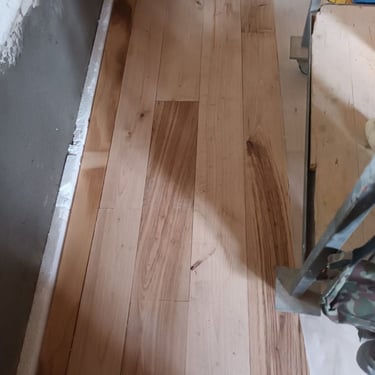
The floors go down
With the first layer of flooring in place, all the additional earthquake bars could go in. These didn't just go through the outside walls, they also went through the internal walls. This tied the whole structure together through the walls, turning the floor into a structural component of the building.
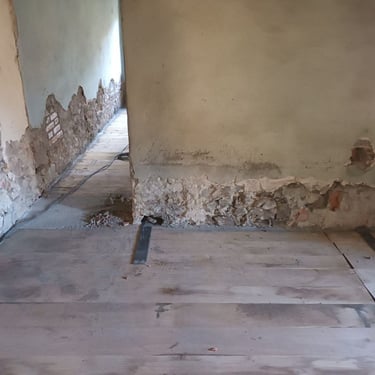
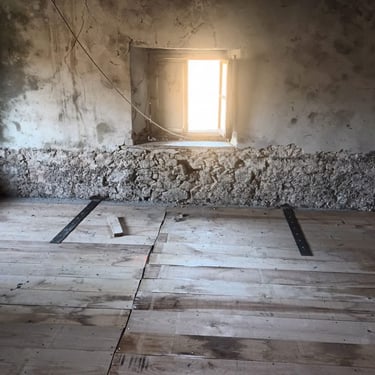


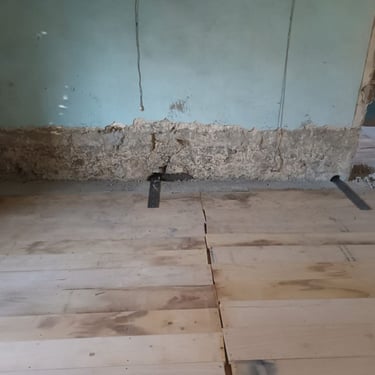
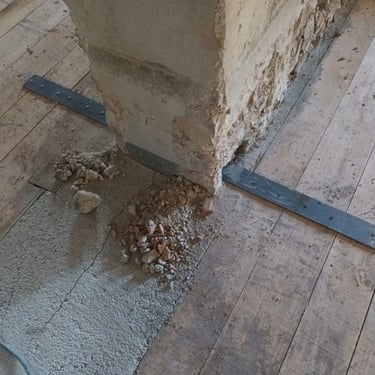

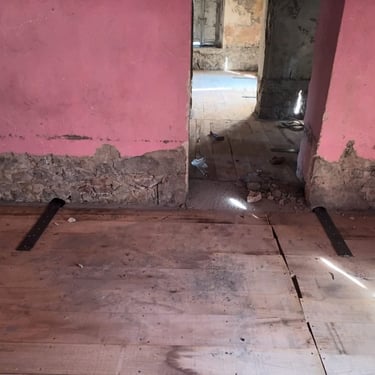
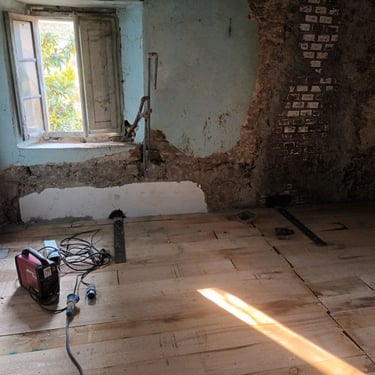

Earthquake bars
With the earthquake bars in place, the top layer of wooden flooring could be laid. The results were spectacular.
It seemed strange to think that these rooms, which felt like such a natural part of the house, had not existed for maybe fifty years or more. We had recreated them.
The experience of being able to walk on real floors and move around the space was amazing, especially after all the grief we had gone through - all the complications of covid and the stress of not knowing if we were going to be able to pull it off. The builders had done a fantastic job and everyone involved had pulled out all the stops and the results were amazing.
It was a shame it was all about to be ruined by what happened next.
The finished floors

There are times in your life when something happens that makes everything else pale into insignificance. For me this was 26 August 2022.
Although the work had been going well our finances were a mess. We had gone into this project with the costs worked out and just enough money in the bank to cover everything but we didn't have much room to manoeuvre.
When Covid came along it blew all of our plans out of the water, and by the time the floors were finished we had run out of cash. Not only was there not enough to do the roof, we’d had to borrow money to finish the floor.
The roof had turned out to be in a much worse state than we had thought. The concrete floor of the loft had masked how much water was leaking in when it rained. Now that the concrete was gone, we could see that the roof desperately needed fixing, but we had no money left.
We were lucky that we had started doing vacation rentals in 2021 with the new house that we’d built to replace the old barn, and that was bringing in some cash, but every penny of our savings was gone. We had managed to borrow money from friends, and that, plus overdrafts and credit cards, had given us enough to pay the builders.
But the house was far from finished and we were completely broke. Our stress levels were building, and things were about to get a whole lot worse.
(If you don't like descriptions of injuries you may want to skip this part and go to the next section).
There should really be a label on chainsaws that says "Do not use while stressed and distracted".
We had a bad storm. It damaged a tree outside the front of the house and brought down several big branches, and they were getting in the way. I needed to cut them up and move them.
Most of the branches were small enough to cut up with pruning shears, but some were quite big and the shears just weren’t heavy duty enough to get through them.
While struggling with the shears and becoming increasingly frustrated, I noticed my chainsaw. In a hurry now, and somewhat annoyed, I picked up the chainsaw and got ready to cut a branch.
The branches were piled onto an old pallet, but the branch I was about to cut was far from straight and it was difficult to hold. I was steadying it with my right foot on one side and, as the wood twisted away from me, my left foot on the other side - to the left and forward of the chainsaw.
I started to cut.
Almost immediately, the teeth of the cutting chain got briefly trapped in the wood and the saw jumped out of the cut. This is called a "kickback" and it’s not uncommon when using a chainsaw; if you’re prepared for it, and aware of the risk, you’re usually OK. But I wasn't thinking about what I was doing and had no protective gear on.
The chain was almost new and it was very, very sharp. The saw blade went straight into the lower part of the back of my leg, instantly severing my Achilles tendon, as well as the tendons to my two smallest toes. It went through my nerves, through the muscle, and through the surrounding tissue. Having gone through all the soft tissue it continued into my tibia (shin bone).
The cut began at my heel and continued up through the lower part of my calf muscle and then into the bone. The injury was horrendous, lacerations and rough cuts everywhere.
The only good thing, if it can be described as such, is that I managed to miss the major blood vessels, although how, I have no idea. So while there was plenty of gore and torn flesh, at least there I wasn’t about to die from loss of blood.
The first thing that happened was I fell over; without a functioning Achilles tendon I was down to one leg. The chainsaw had stopped but I was on the ground with a massive open wound about 30cm long and down to the bone.
I put my hand around my leg to hold it together and shouted for Ana. Luckily, she heard me and came running. She took it all in and ran back inside to find something clean to wrap around the wound. Returning with a bed sheet, we wrapped the wound as best we could and, with the help of one of our vacation guests from the new house (that’s a holiday he won’t forget in a hurry), got me into the car and raced to the local hospital.
If you are ever going to have an accident with a chainsaw, I strongly advise you to do it in a place where everyone has a chainsaw. The local hospital staff will have had plenty of similar accidents to practise on.
The staff at Santa Croce di Castelnuovo di Garfagnana (Castelnuovo hospital) were brilliant. They got me onto a table, cleaned the wound and quickly stitched me up to stop the bleeding and reduce the risk of infection. At this point I thought, wow that was quick, looks like I’ll be home for dinner.
Not a chance.
They admitted me and settled me into a bed for the night, and then at 6 the following morning I went under the knife for about two and a half hours with possibly the grumpiest surgeon in the world and the nicest anaesthetist. The anaesthetist and the other operating room staff amused themselves by making funny Brexit and chainsaw jokes at my expense. They had given me an epidural so I was fully conscious through the whole operation, giving them plenty of time to make up lots of new jokes.
When I eventually got to see the wound I couldn't believe what an amazingly tidy job they had done. They had even managed to get my toes sort of working, and although I had no feeling in the bottom of my foot I felt confident it would eventually return.
Truly quite amazing. I was in the hospital for four days and came out with my leg in a plastic boot.
Ooooooops....

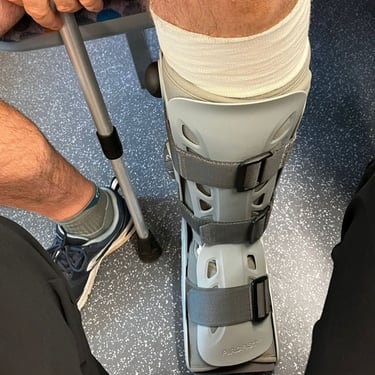
This changes everything
In a bizarre sort of way this horrible accident may actually have been a good thing. I had become increasingly stressed out about the big hole we now found ourselves in and I was probably not much fun to live with. I’d been running around feeling lost, unable to see a way forward and totally overwhelmed by the task ahead.
The accident just stopped everything. Now all I could do was sit still. I couldn't do anything without help.
It would be a couple of weeks before I could even hobble around. After that I faced months of physiotherapy. And I would not get back to the house again until the beginning of 2023.
By then the beautiful new wooden floors were ruined. Rainwater had poured through the roof and even with tarps down and buckets under the worst leaks we hadn’t been able to prevent a huge amount of damage.
The pristine wood was badly water stained, and as it got wet it had expanded and pulled all the screws out. Every room upstairs was damaged, with floor boards sticking up like a deranged game of Jenga.
It was a disaster but, strangely, one that I now felt in a much better mental state to deal with.
2023 became a year of recovery. Assessing our situation, we could see that although we were broke, we had things going for us.
We had blown through our March 2021 deadline for finishing the renovation, but It seems that our geometra had put in a good word with the authorities on our behalf. The commune allowed us to keep working.
The floors were in a terrible state. They were horribly stained and some of the planks had expanded so much that they would not fit together any more, but they were not beyond rescue.
So I got back to work. I began upstairs, pulling up all the boards that looked wet or damaged and stacked them so air could move around them and they could slowly dry out. In the end, I pulled up about a third of all the boards on the upstairs floor.
Fortunately, as part of the redesign, a layer of insulation had been put between the two layers floorboards, and this stopped a lot of the water from reaching downstairs. So while the upstairs floors were a real mess, the downstairs floors weren’t in such bad shape.
The staining on the wet floorboards was really bad. The rainwater leaking in through the roof picked up tannins from the wood as it seeped through, and this seriously stained the floor, leaving dark brown blotches everywhere.
However, the year ended with things looking better. We had the frame of the staircase in place, and this was a substantial piece of work. Regulations had changed while we were in the process of renovating, and we’d had to add significantly more reinforcing to the staircase frame than we’d anticipated - or budgeted for.
But on the whole things were moving in a more positive direction. The vacation rental was growing and the money from it helped to pay off our debts and enabled us to save money for the thing we needed most of all, a new roof.

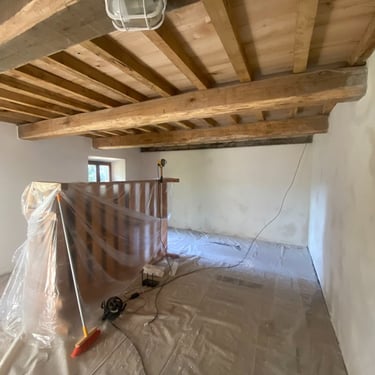

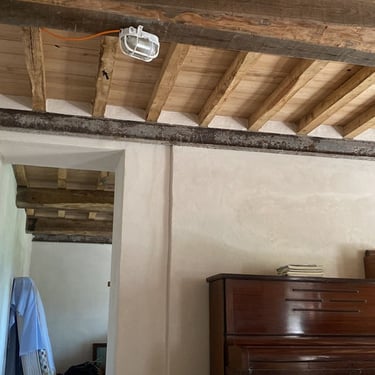
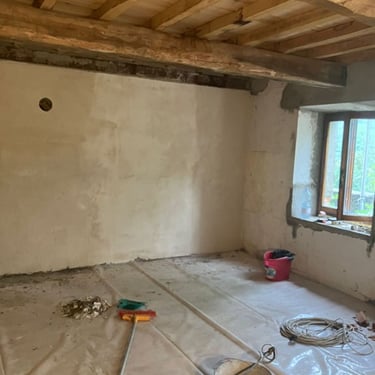
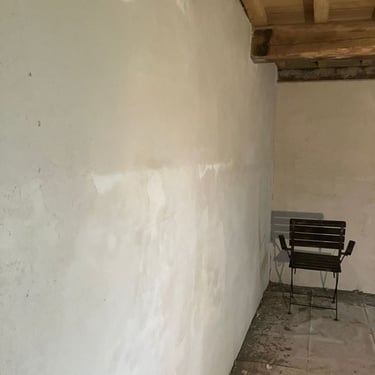
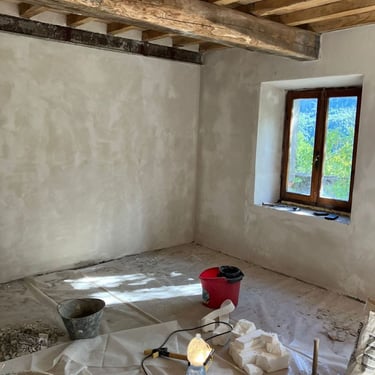

Restarting
By the beginning of 2024 our finances were in a much better state. We had saved nearly all of our income from vacation rentals and that meant we were ready to start work on the new roof.
It would have 150mm of insulation, which would keep the house warm in the winter and cool in the summer heat. It would be a lot more comfortable. We were also going to add a few more things that we hadn't budgeted for but that made sense. The roof was going to be considerably beefed up, structurally, with more steel-work for earthquake resistance.
Following advice from our geometra we decided to instal solar panels, which would vastly improve the energy efficiency of the house and reduce the running costs. Finally, we got the underside of the roof sandblasted to get rid of all the old paint.
So the year started well, but I still had a problem to solve: how to fix the floors.
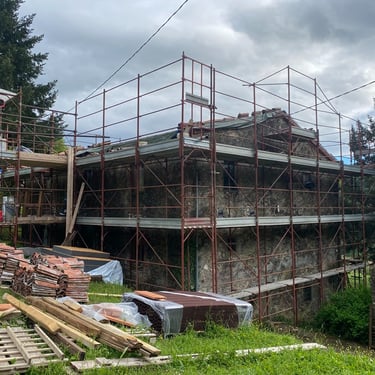
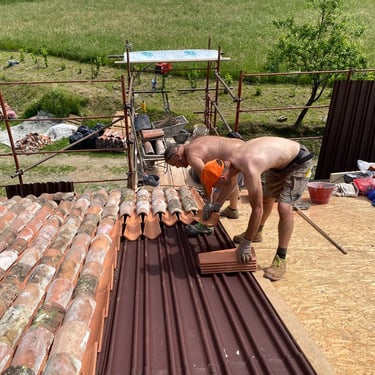
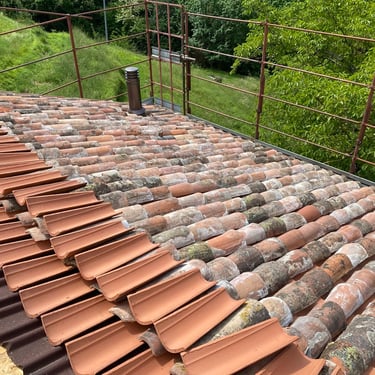
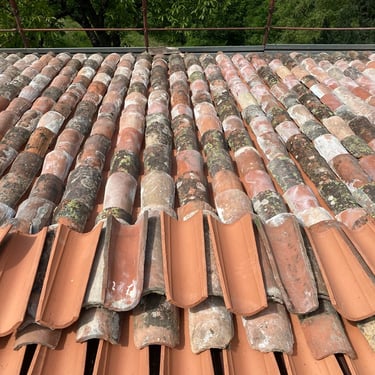
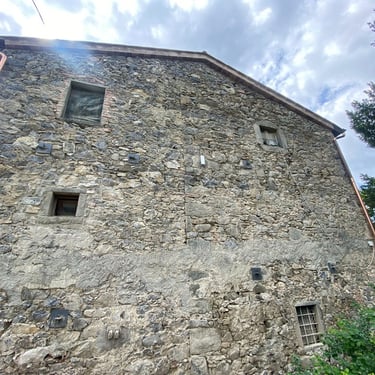
The new roof
In 2024 we replastered the upstairs rooms. I had to come up with some completely new techniques for this as I didn't want to get rid of the old plaster - it had probably been there for 200 years or more.
I wanted to preserve the old but find ways of adding the new and blending them seamlessly together.
More on this in a blog post
Replastering

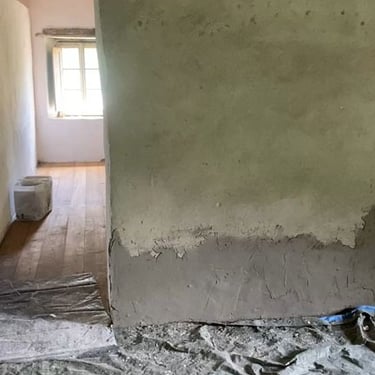
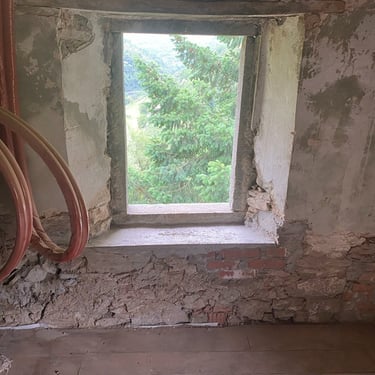
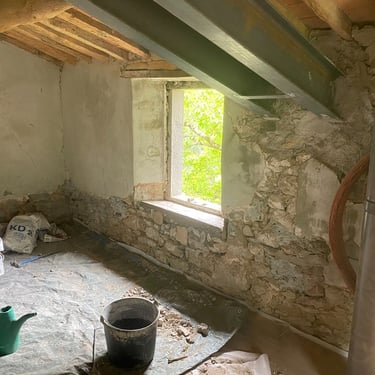
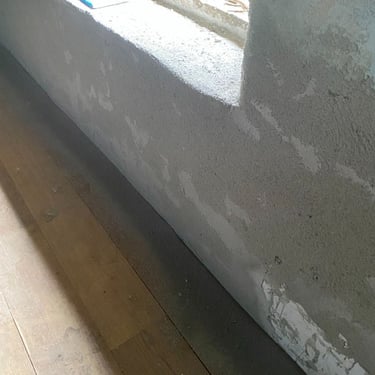

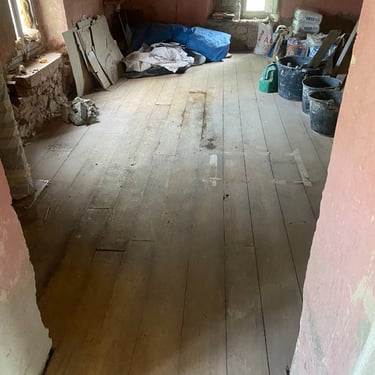

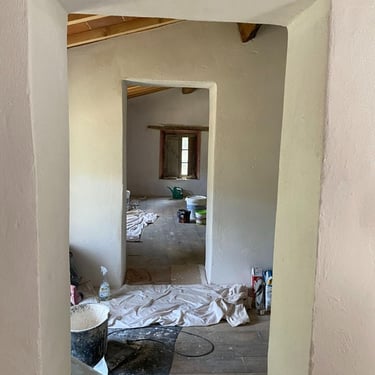
Another major task was the downstairs floors. While I’d already finished installing both layers of floorboards in some of the space, I still needed to complete the kitchen, hallway, and bathroom floors, and I was planning to use them as a pilot for dealing with the staining and discoloration on the floors upstairs.
I was laying new wood downstairs, but the finishing process that I used finally enabled me to come up with a way of dealing with the damage upstairs.
I am going to cover this in a detailed blog post as it deserves a fuller explanation.
Downstairs floors
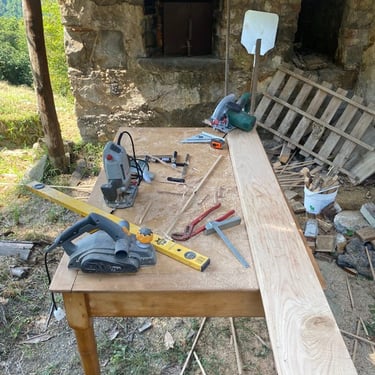
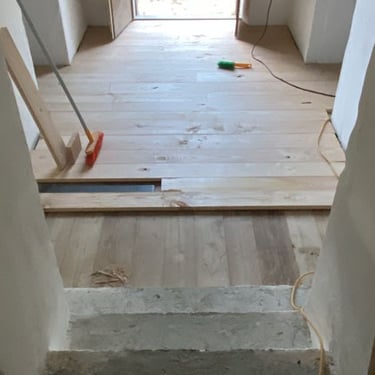
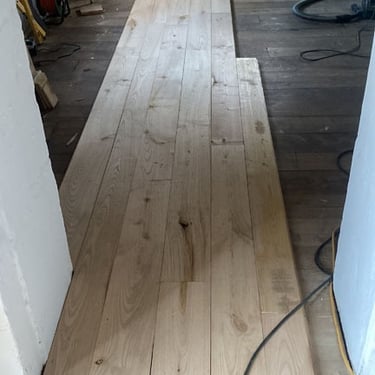
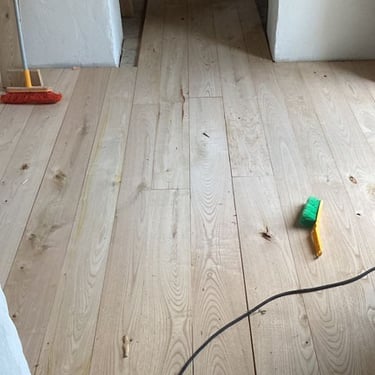



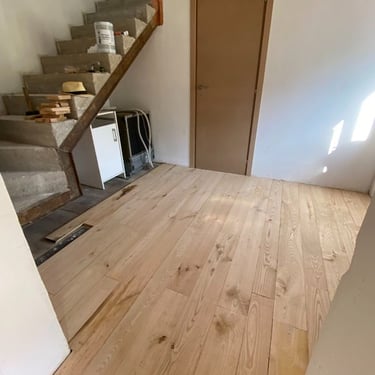
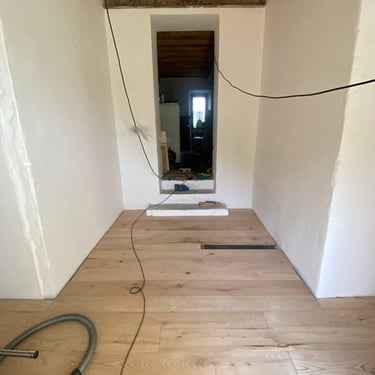
Towards the end of 2024, the commune, having been admirably patient so far, informed me that the renovation work now needed to be completed by June 2025.
I still had a lot to do. One of the biggest challenges was refurbishing the original windows, which I’d found stacked up in the loft and wanted to reuse. But I also had to fit Juliet balconies and deal with water, instal electrical conduits and many other tasks.
The photos tell some of the story of the window renovation; more details are in a blog post.
Refurbishing windows
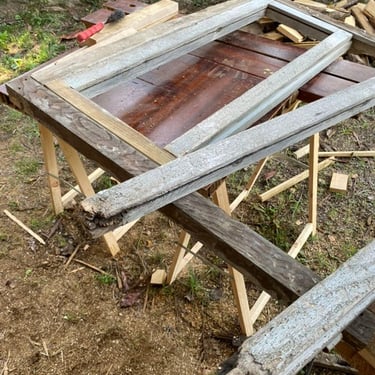
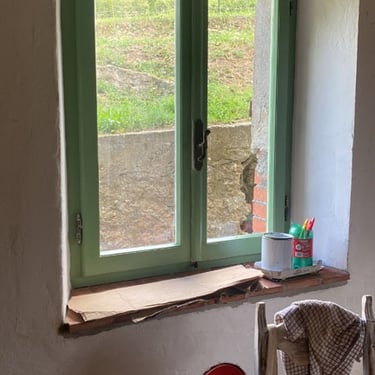
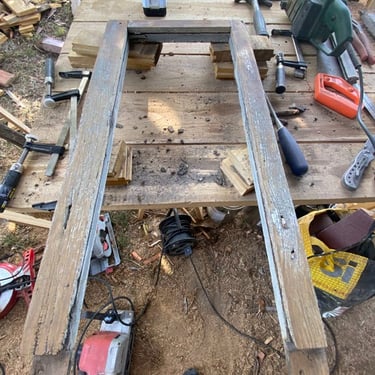

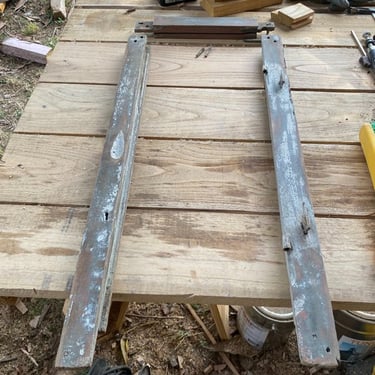
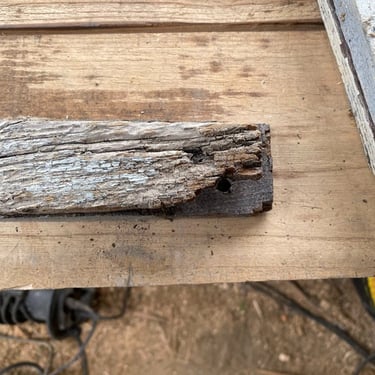
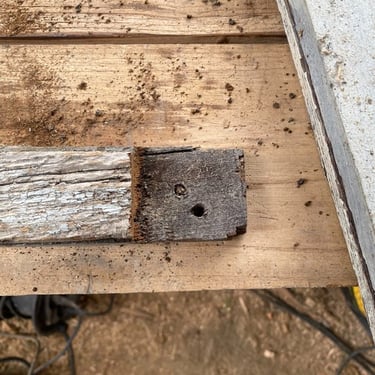
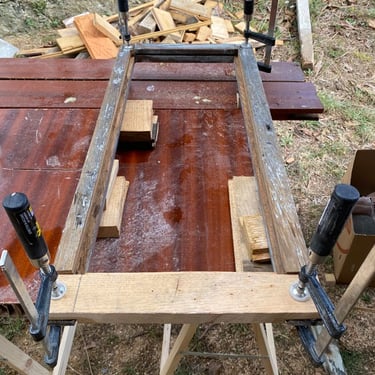

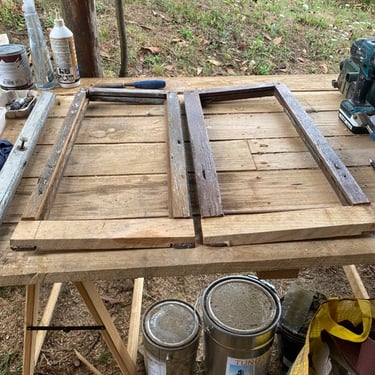
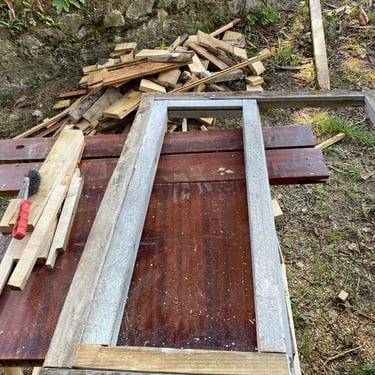

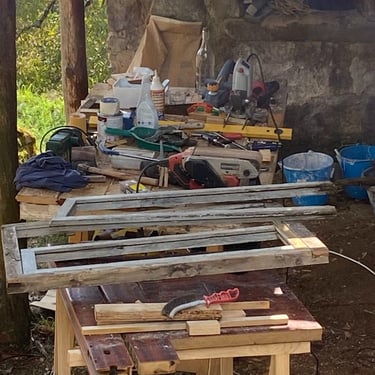
One of the tasks on my list was to finish the treads of the stair steps. I have to point out that I am not a professional carpenter, but I really do like working in wood and I found building the stairs to be immensely gratifying.
I’m going to cover this in more detail in a stand-alone blog post but, for now, here are some pictures of my lovely wooden steps.
Finishing the stairs

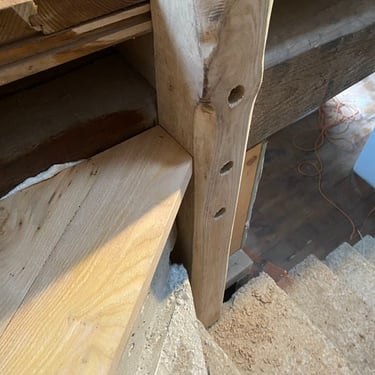
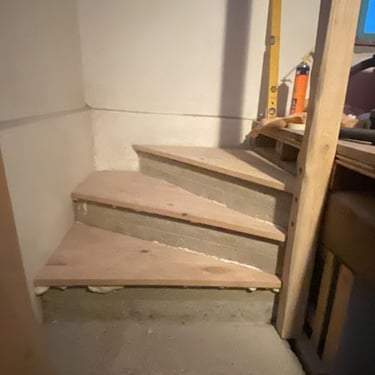

Another big item on the to do list was to get the upstairs bathroom walls up. Rather than using timber studs, I went for galvanised steel, mostly because it’s fast and easy to use.
Steel studs are very versatile. If you need extra strength, you just put the uprights closer together. The steel can be cut with hand-held tin snips, so there’s no sawdust to clean up, and you can get self-tapping screws for quickly fixing on the plaster boards.
These walls were completed in about two days.
Second bathroom walls
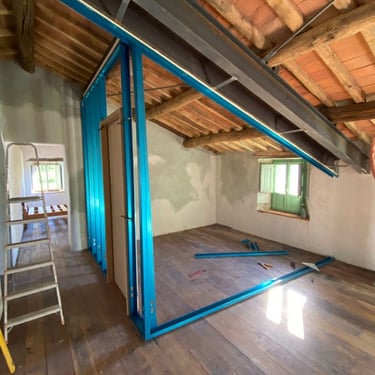

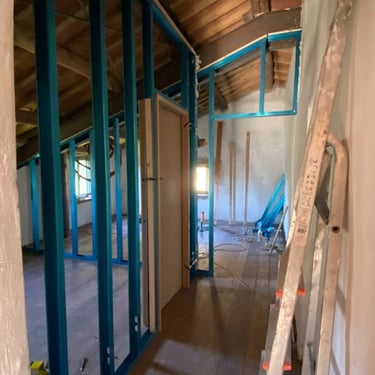
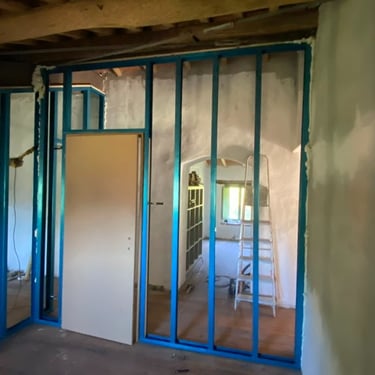

After the upstairs bathroom was finished, I had to get the electrics sorted out. I am not qualified to do the wiring but I could put all the conduit in place.
So I opted to put the electrical wiring and switches on the surface in most places and bury them in the wall where there was an available depth of plaster. This simplified the installation and it looks appropriately old school, and I also like it because it makes everything easily accessible.
I finished the welding of the railings and the balconies, and completed the walls for the bathroom, including a double layer of plasterboard to act as soundproofing between the bathroom and the adjacent bedroom.
Electrics & balconies
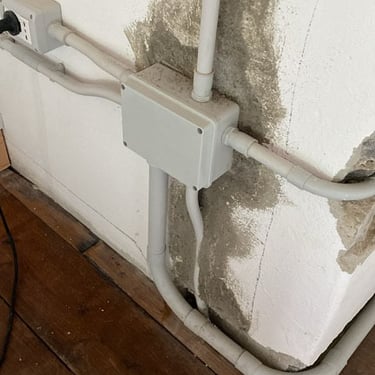
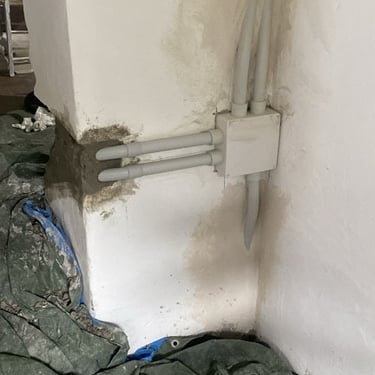

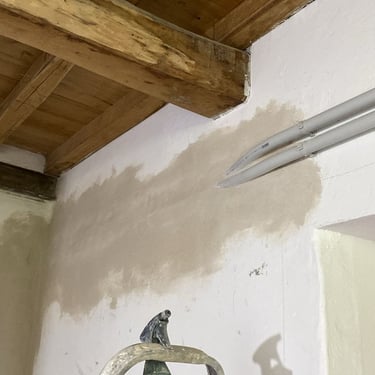
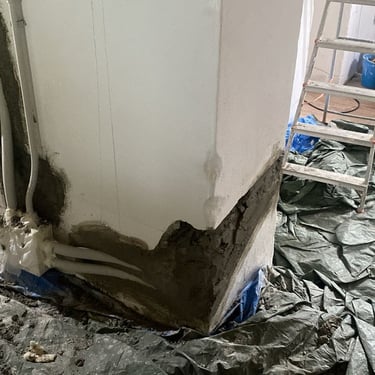

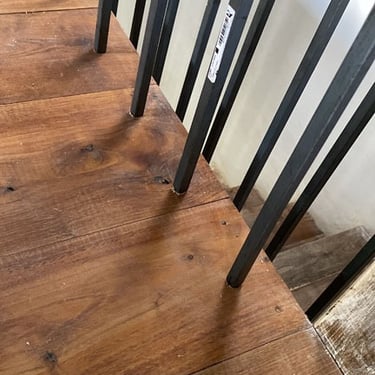
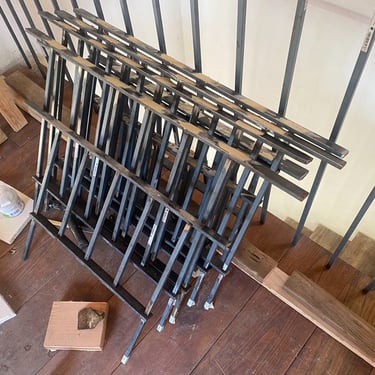
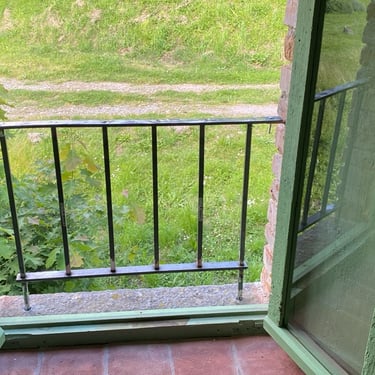
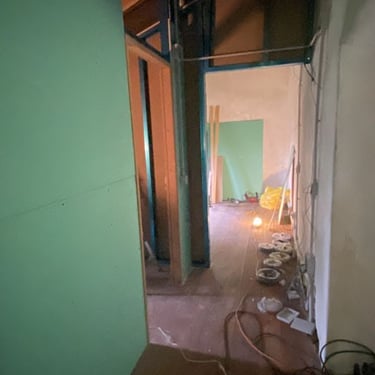
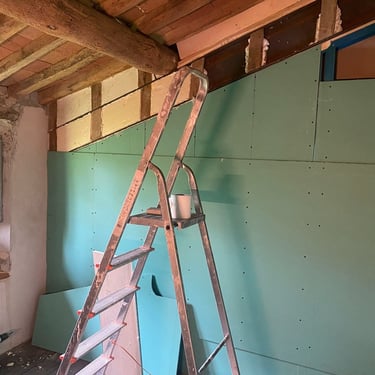

Progress as of 6 June 2025

So by June we were in a much better place, all the things on my list had been done. We had electrics, a proper staircase with railings, the windows had been sorted and painted and we had juliet balconies on all the windows that needed them. I had also insulated under the floor downstairs which meant the house was now a lot more comfortable.